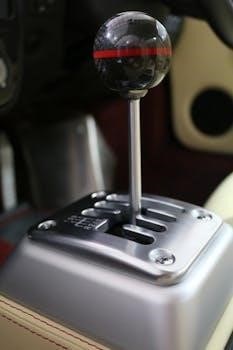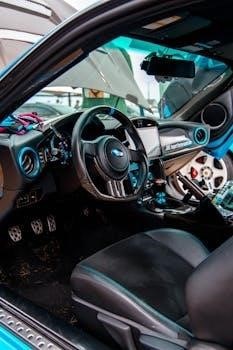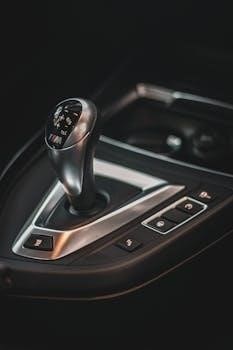
auto starter for manual transmission
Auto starters‚ while commonplace in automatic vehicles‚ are less frequently seen in manual transmission cars. This difference stems from the fundamental way manual gearboxes and their clutches operate‚ requiring a more hands on start.
Understanding the Basics of Manual Transmissions
Manual transmissions‚ often referred to as stick shifts‚ require the driver to manually select gears using a clutch pedal and gear lever. Unlike automatic transmissions‚ which shift gears automatically‚ a manual system relies on the driver’s input to engage and disengage the engine from the wheels. The clutch mechanism is crucial; it temporarily disconnects the engine’s power from the gearbox‚ allowing the driver to shift into the desired gear without causing damage. This system provides the driver with more direct control over the vehicle’s power and torque. This hands-on approach is what differentiates manual transmissions. The driver must coordinate clutch engagement‚ throttle input‚ and gear changes for smooth operation‚ this also plays a key role in the function and necessity of auto starters. This coordination requires skill and practice‚ making the driving experience quite different compared to an automatic transmission.
Why Auto Starters are Less Common in Manual Cars
The primary reason auto starters are less common in manual cars is the inherent safety risk associated with starting in gear. Unlike automatics‚ which must be in ‘Park’ or ‘Neutral’ to start‚ a manual car can potentially start while a gear is engaged. If a driver were to start a manual car in gear‚ the vehicle could lurch forward or backward unexpectedly‚ leading to accidents. This danger has historically made manufacturers hesitant to implement auto start systems in manual vehicles. The complex coordination between the clutch and gear selection required for manual transmissions makes it difficult to create a safe and reliable automated starting system. Moreover‚ the manual transmission’s design‚ which relies on driver engagement‚ often clashes with the idea of automatic starting. The need for driver control during the start-up process makes the integration of an automatic start system more challenging to implement safely‚ leading to their rare usage compared to automatic vehicles.

Types of Starter Motors Used
Two main types of starter motors are commonly found⁚ conventional and reduction types. These differ in their internal mechanics‚ impacting how they engage with the engine for starting.
Conventional Type Starter Motors
Conventional starter motors represent a more traditional design‚ often found in older vehicles‚ though still utilized in some modern applications. These motors operate on a relatively straightforward principle‚ directly transferring the rotational force generated by the electric motor to the engine’s flywheel or flexplate through a drive pinion gear. This direct connection means that the motor’s speed and torque are directly proportional to the speed and torque applied to the engine for starting. The internal components of a conventional starter motor typically include a solenoid‚ which acts as a switch to engage the motor‚ a set of brushes that conduct electricity to the commutator‚ and the motor windings themselves. These components work in concert to convert electrical energy into the mechanical force required to turn the engine over. While robust and reliable‚ conventional starter motors can be larger and heavier compared to their reduction-type counterparts‚ making them a design choice often dictated by space constraints and cost considerations. They generally have a simpler design‚ which can be advantageous in terms of maintenance and repair.
Reduction Type Starter Motors
Reduction-type starter motors‚ a more advanced design‚ incorporate a planetary gear system to increase the torque delivered to the engine. This gear reduction allows the motor to spin at a higher speed‚ while the output shaft turns the engine at a lower‚ but more powerful‚ rate. The planetary gears‚ often nestled within the motor housing‚ effectively multiply the torque‚ allowing for a smaller and lighter overall motor design. This is particularly beneficial in modern vehicles where space constraints are a significant factor. Additionally‚ the higher speed of the motor allows for more efficient use of electrical energy‚ contributing to improved starting performance. Key components of a reduction type starter motor include the solenoid‚ brushes‚ commutator‚ and the gear reduction mechanism. The use of planetary gears results in higher torque output‚ and they are often preferred for their compact size and efficiency. Reduction type starter motors also tend to be more reliable and durable‚ making them a common choice in modern automotive designs.

Key Components of a Starter Motor
A starter motor consists of several key components working together‚ including a solenoid‚ pull-in and hold-in coils‚ a plunger‚ commutator‚ brushes‚ a drive pinion gear‚ and the motor housing.
The Solenoid and its Function
The solenoid is a crucial electromagnetic switch within the starter motor. Its primary function is to engage the starter motor’s drive pinion gear with the engine’s flywheel ring gear. When the ignition key is turned‚ a small electrical current flows to the solenoid‚ creating a magnetic field. This field pulls a plunger‚ which in turn pushes the drive pinion gear forward. Simultaneously‚ the solenoid completes the high-current circuit that powers the starter motor itself. The solenoid’s pull-in and hold-in coils work together to ensure the pinion gear stays engaged until the engine starts. Once the engine runs and the ignition key is released‚ the solenoid disengages‚ retracting the pinion gear and stopping the starter motor. This process prevents the starter motor from being damaged by the engine’s higher rotational speed. The solenoid’s role is vital for the smooth and reliable initiation of the engine. Without it‚ the starter motor wouldn’t be able to transfer the necessary rotational force.
The Role of the Drive Pinion Gear
The drive pinion gear is a small‚ robust gear located at the front of the starter motor’s shaft. Its primary role is to mechanically link the starter motor to the engine’s flywheel. When the solenoid is energized‚ it pushes the drive pinion gear forward to engage with the flywheel’s ring gear. This engagement is crucial because it allows the starter motor’s rotational force to be directly transferred to the engine‚ initiating its rotation. The teeth of the pinion gear are specifically designed to mesh precisely with the teeth of the flywheel‚ ensuring a firm and efficient transfer of power. Once the engine starts‚ the pinion gear must disengage quickly to avoid being damaged by the much higher speed of the running engine. This disengagement is typically achieved by retracting the plunger and spring. The design and durability of the drive pinion gear are vital for the reliable starting of the engine.

Challenges and Considerations
Implementing auto starters in manual vehicles presents unique hurdles‚ mainly due to the clutch and gear engagement. Safety interlocks are essential to prevent accidental starts in gear‚ requiring additional engineering.
Engine Start-Up in Manual Transmission Vehicles
Starting a manual transmission car involves a specific sequence that differs significantly from an automatic. The driver must depress the clutch pedal‚ ensuring the transmission is disengaged from the engine‚ before turning the ignition key. This process is crucial to prevent the vehicle from lurching forward or stalling. Unlike automatics‚ where the transmission is always in a neutral position at start-up‚ manual cars require this manual intervention. The driver also needs to ensure the gear lever is in neutral‚ or the clutch is fully depressed‚ to avoid a sudden movement. This added layer of control is part of the manual driving experience and a necessary step for safe engine starting. The starter motor engages with the engine flywheel‚ turning it over so the combustion process starts. The successful start relies on all these factors working seamlessly. This coordinated action between the driver and the vehicle highlights the distinct starting procedure.
Safety Mechanisms and Interlocks
Safety mechanisms are paramount in manual transmission vehicles‚ especially concerning starting procedures. A critical safety feature is the clutch interlock‚ which prevents the starter motor from engaging unless the clutch pedal is fully depressed. This interlock ensures the transmission is disengaged before the engine cranks‚ preventing unexpected movement of the car. This reduces the risk of accidents during startup if the car is in gear. Another safety measure may include a neutral safety switch which ensures the starter can only work when the gear lever is in neutral‚ adding another safeguard against unintended vehicle motion. These interlocks are designed to protect the car‚ driver and other road users. Without these safety mechanisms‚ the potential for an uncontrolled start would be significantly higher‚ making them a vital part of manual transmission starting systems. Modern vehicles include a combination of these measures for a safe starting process.

Benefits of Auto Starters
Auto starters offer increased convenience‚ eliminating the need for manual cranking or push starts. They also provide the possibility of remote starting‚ which can be especially useful in cold weather conditions.
Convenience and Ease of Starting
The primary advantage of an auto starter in a manual transmission vehicle lies in its convenience. Traditional manual start methods‚ whether by hand crank or requiring a push‚ are physically demanding and can be unreliable‚ especially in unfavorable conditions. Auto starters simplify this process‚ allowing for quick and effortless engine ignition with the simple turn of a key or push of a button. This ease of use is particularly beneficial for individuals who may have difficulty with manual starting procedures‚ such as those with mobility limitations or in situations where manual starting is simply inconvenient. The reduction in physical effort also translates into a more comfortable and less stressful starting process. Furthermore‚ automatic starting provides a consistent and reliable ignition every time‚ eliminating the variability often associated with manual start attempts. This reliability ensures that the vehicle is ready to use when needed‚ enhancing the overall driving experience and user satisfaction. The benefits are clear in offering a modern solution to an older process.
Potential for Remote Starting
The integration of an auto starter system in a manual transmission vehicle opens up the possibility of remote starting‚ a feature that significantly enhances user convenience. Remote starting allows the driver to start the vehicle from a distance‚ often using a key fob or smartphone app. This is particularly advantageous in extreme weather conditions‚ allowing the engine to warm up or the air conditioning to cool down the cabin before the driver enters the vehicle. This functionality provides a more comfortable and convenient start to the journey. The remote start feature also addresses safety concerns‚ offering a secure way to start the vehicle without having to be physically present inside. It can also be utilized to activate other features like defrosting‚ which improves visibility during winter driving. The ability to start the vehicle remotely is a modern feature that offers a step up in convenience compared to traditional manual methods‚ and can be a very attractive option for car owners.